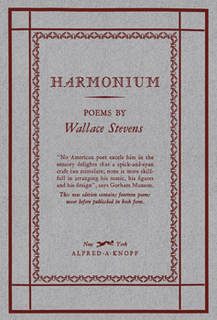Related Research Articles

Wallace Stevens was an American modernist poet. He was born in Reading, Pennsylvania, educated at Harvard and then New York Law School, and he spent most of his life working as an executive for an insurance company in Hartford, Connecticut. He won the Pulitzer Prize for Poetry for his Collected Poems in 1955.

Harmonium is a book of poetry by American poet Wallace Stevens. His first book at the age of forty-four, it was published in 1923 by Knopf in an edition of 1500 copies. This collection comprises 85 poems, ranging in length from just a few lines to several hundred. Harmonium was reissued in 1931 with three poems omitted and fourteen new poems added.
"The Worms at Heaven's Gate" is a poem from Wallace Stevens' first book of poetry, Harmonium (1923). It was first published in 1916 and is therefore in the public domain.
"Ploughing on Sunday" is a poem from Wallace Stevens's first book of poetry, Harmonium (1923). First published in 1919, it is now in the public domain.
"Homunculus et la Belle Etoile" is a poem from Wallace Stevens's first book of poetry, Harmonium. It was first published in 1919.
"The Comedian as the Letter C" is a poem from Wallace Stevens's first book of poetry, Harmonium (1923). It was one of the few poems first published in that collection and the last written for it. John Gould Fletcher frames the poem as expressing Stevens's view "that the artist can do nothing else but select out of life the elements to form a 'fictive' or fictitious reality."
"Of the Surface of Things" is a poem from Wallace Stevens's first book of poetry, Harmonium (1923). It was first published in 1919, so it is in the public domain.
"Anecdote of the Prince of Peacocks" is a poem from Wallace Stevens's first book of poetry, Harmonium (1923). It was one of the few Harmonium poems first published in that volume, so it is still under copyright. However, it is quoted here as justified by Fair use to facilitate scholarly commentary.
"Banal Sojourn" is a poem from Wallace Stevens's first book of poetry, Harmonium. It was originally published in 1919, therefore it is in the public domain.
"Depression Before Spring" is a poem from Wallace Stevens's first book of poetry, Harmonium (1923). It was first published in 1918 and is therefore in the public domain.
"The Cuban Doctor" is a poem from Wallace Stevens's first book of poetry, Harmonium. It was first published in the journal Poetry in October 1921, so it is in the public domain.
"Stars at Tallapoosa" is a poem from Wallace Stevens's first book of poetry, Harmonium. It was first published in 1922, so it is in the public domain.
"Six Significant Landscapes" is a poem from Wallace Stevens's first book of poetry, Harmonium. It was first published in 1916, so it is in the public domain.
"Anecdote of the Jar" is a poem from Wallace Stevens's first book of poetry, Harmonium. First published in 1919, it is in the public domain.
"Palace of the Babies" is a poem from Wallace Stevens's first book of poetry, Harmonium. It was first published in 1916 and is therefore in the public domain.
"Life is Motion" is a poem from Wallace Stevens's first book of poetry, Harmonium. It was first published in 1919, so it is in the public domain.
"Theory" is a poem from Wallace Stevens's first book of poetry, Harmonium. It was first published in 1917, so it is in the public domain.
"Hymn From A Watermelon Pavilion" is a poem from Wallace Stevens's first book of poetry, Harmonium. It was first published in 1917, so it is in the public domain.
"The Man Whose Pharynx Was Bad" is a poem from Wallace Stevens's first book of poetry, Harmonium. First published in 1921, it is in the public domain in the United States.
"The Public Square" is a poem from the second edition (1931) of Wallace Stevens's first book of poetry, Harmonium. It was first published in 1923, so it is one of the few poems in the collection that is not free of copyright, but it is quoted here in full as justified by fair use for scholarly commentary.
References
- Buttel, Robert. Wallace Stevens: The Making of Harmonium. 1967: Princeton University Press.